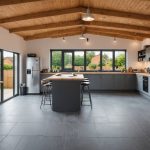Loft conversions in the UK offer exciting opportunities for expanding your living space, but the summer heat can turn these inviting retreats into unbearable saunas. Affordable cooling systems are key to enjoying your loft in comfort. This guide explores practical, budget-friendly solutions tailored specifically for UK homes. Discover how to transform your loft into a refreshing sanctuary, ensuring a pleasant atmosphere year-round without breaking the bank. Embrace the potential of your space while keeping cool!
Understanding Loft Conversions and Cooling Needs
Loft conversions have become a popular trend in UK homes, offering a practical way to maximise space without the need for an extension. This transformation can turn an underutilised attic into a functional area, such as a bedroom or office. However, with this newfound utility comes the challenge of managing cooling needs.
Cela peut vous intéresser : Unlocking Backyard Dreams: Navigating the Legalities and Restrictions of Tiny Home Construction in the UK
Loft spaces are notorious for heat retention, especially during the summer months. The roof's proximity to the sun and the potential for inadequate insulation can lead to uncomfortable temperatures. Addressing these cooling needs is crucial to ensure the converted loft remains a comfortable and usable space throughout the year.
Several factors influence the cooling requirements of a loft conversion. The size of the loft plays a significant role; larger spaces may require more robust cooling solutions. Insulation quality is another critical factor. While good insulation helps retain heat during winter, it can also trap heat in the summer, necessitating effective ventilation or air conditioning systems. Lastly, the intended usage of the loft can dictate cooling needs. For instance, a bedroom may require different cooling solutions compared to a home office. Understanding these elements can help homeowners make informed decisions when planning their loft conversions.
En parallèle : Unlocking Backyard Dreams: Navigating the Legalities and Restrictions of Tiny Home Construction in the UK
Types of Cooling Systems for Loft Conversions
Choosing the right cooling systems for loft conversions is essential to maintaining comfort. Various options are available, each with distinct benefits and drawbacks.
Air Conditioning
Air conditioning units provide efficient cooling, swiftly reducing temperatures. They are ideal for larger lofts or spaces with high heat retention. However, they can be costly to install and operate, and may require regular maintenance. Energy-efficient models can mitigate some of these concerns, offering cooling without excessive energy consumption.
Ventilation
Ventilation systems, such as exhaust fans or roof vents, are a cost-effective solution. They work by circulating air, helping to reduce heat buildup. While they are less powerful than air conditioning, they are more energy-efficient and environmentally friendly. Ventilation is best suited for lofts with moderate cooling needs.
Passive Cooling
Passive cooling involves design strategies like reflective roofing or strategic window placement to minimise heat gain. This method is energy-efficient and sustainable, but its effectiveness depends on the loft's design and location. It may not suffice in extremely hot conditions or poorly insulated lofts.
Each system offers unique advantages, and the choice should align with the loft's specific requirements and the homeowner's energy efficiency goals.
Budget-Friendly Cooling Solutions
Finding affordable cooling options for loft conversions can be a balancing act between cost and comfort. Understanding the cost breakdown of various cooling systems is essential for making an informed decision. Ventilation systems, such as exhaust fans, are among the most cost-effective solutions. They are affordable to install and maintain, providing a steady flow of air to reduce heat buildup.
When selecting budget-friendly cooling options, consider the loft's specific needs and your financial constraints. Energy-efficient air conditioning units, although initially more expensive, can offer long-term savings on electricity bills. Look for models with high energy efficiency ratings to maximise cost savings.
For those inclined towards DIY options, there are several projects that can enhance loft cooling without significant expense. Installing reflective window films or using thermal curtains can help reduce heat gain. Additionally, creating cross-ventilation by strategically opening windows can significantly improve airflow.
Consider these cost-effective solutions:
- Exhaust fans for improved ventilation
- Reflective window films to minimise heat
- Thermal curtains to block sunlight
By exploring these affordable cooling methods, homeowners can enjoy a comfortable loft space without exceeding their budget.
Insulation and Its Role in Cooling
Proper insulation is crucial in regulating temperature within a loft conversion. It acts as a barrier, preventing heat from entering during the summer and escaping in the winter. This not only enhances thermal performance but also significantly boosts energy efficiency.
Importance of Proper Insulation
Insulation plays a pivotal role in maintaining a comfortable environment. Without it, lofts are prone to overheating, leading to increased reliance on cooling systems. Effective insulation reduces the need for constant air conditioning, thereby lowering energy bills.
Types of Insulation Materials
Several insulation materials are suitable for lofts, each offering unique benefits:
- Fibreglass: Cost-effective and easy to install, it provides good thermal performance.
- Spray Foam: Offers superior air sealing properties, filling gaps and cracks effectively.
- Rigid Foam Boards: Known for high insulating value, ideal for spaces with limited depth.
Impact on Cooling Efficiency
The choice of insulation directly affects cooling efficiency. High-quality insulation materials can reduce heat transfer, minimising the need for artificial cooling. This not only conserves energy but also extends the lifespan of cooling systems by reducing their workload. Investing in proper insulation is thus a strategic decision for long-term energy savings.
Installation Considerations
Installing a cooling system in a loft conversion requires careful planning and execution. Whether opting for professional services or a DIY installation, understanding the process is crucial for success.
Step-by-Step Guide for Installing Cooling Systems
- Assessment: Evaluate the loft's size and cooling needs. This determines the type of cooling system required.
- Selection: Choose the appropriate system, whether it's air conditioning, ventilation, or passive cooling.
- Preparation: Gather necessary tools and materials. Ensure the loft is ready for installation by clearing space and checking for structural issues.
- Installation: Follow manufacturer instructions for installing your chosen system. This might involve mounting units, connecting ductwork, or installing vents.
- Testing: Once installed, test the system to confirm proper operation and efficiency.
Professional Services vs. DIY Installation
Hiring professionals ensures expertise and efficiency, particularly for complex systems like air conditioning. They handle intricate tasks and ensure compliance with regulations. However, DIY installation can be cost-effective for simpler systems like ventilation. It requires careful adherence to guidelines and safety measures.
Common Challenges and Solutions
- Space Constraints: Limited space can hinder installation. Opt for compact systems or consult professionals for customised solutions.
- Electrical Requirements: Ensure the loft's electrical system supports the cooling unit's demands. This may necessitate upgrades or professional assistance.
Maintenance of Cooling Systems
Proper maintenance is essential for ensuring the longevity and efficiency of cooling systems in loft conversions. Regular care not only enhances performance but also reduces the likelihood of costly repairs.
Routine Maintenance Tasks
Different cooling systems require specific maintenance tasks. For air conditioning units, regular cleaning of filters and coils is crucial to maintain airflow and efficiency. Ventilation systems benefit from periodic checks to ensure vents and fans are free of debris. Passive cooling designs, although low-maintenance, require occasional inspections to ensure structural elements like reflective surfaces remain effective.
Signs Indicating Need for Professional Service
Certain signs suggest that professional attention is necessary. Unusual noises, reduced cooling capacity, or increased energy bills can indicate underlying issues. For air conditioning systems, frequent cycling or leaks are clear signals for expert intervention. Ventilation systems may need professional cleaning if airflow is consistently poor.
Tips for Prolonging System Life
To extend the life of your cooling system, follow these maintenance tips:
- Schedule regular inspections to catch issues early.
- Keep surrounding areas clean to prevent dust accumulation.
- For air conditioning, ensure proper refrigerant levels and inspect ductwork for leaks.
By adhering to these cooling system care practices, homeowners can maximise efficiency and system lifespan.
Local Regulations and Compliance
When undertaking a loft conversion, understanding building regulations in the UK is essential to ensure compliance and avoid potential legal issues. These regulations cover structural integrity, fire safety, and energy efficiency, all of which impact the installation of cooling systems.
Overview of Relevant Building Regulations
In the UK, loft conversions must adhere to specific building regulations. Key areas include structural requirements to support the new space, fire safety measures such as escape routes, and thermal efficiency standards to ensure energy conservation. These regulations are designed to guarantee the safety and functionality of the converted space.
Ensuring Compliance with Cooling Systems
To ensure your cooling system complies with loft conversion laws, it is crucial to select products that meet energy efficiency standards and are suitable for residential use. Installation must also adhere to electrical safety codes. Consulting with professionals can help navigate these requirements and ensure proper installation.
Resources for Checking Compliance and Obtaining Permits
Local authorities offer resources for verifying UK compliance. Homeowners can access guidance documents and application forms for necessary permits. Engaging with a qualified architect or builder can also provide valuable insights into meeting regulatory standards, ensuring a smooth approval process for your loft conversion project.
Energy Efficiency and Sustainability
In loft conversions, prioritising energy efficiency not only reduces costs but also supports environmental sustainability. Cooling systems are a key area where efficiency can be maximised. Choosing systems with high energy ratings ensures effective cooling with minimal energy consumption.
Tips for Reducing Energy Consumption
To enhance energy efficiency, consider implementing these strategies:
- Insulation: Ensure proper insulation to minimise heat transfer and reduce reliance on cooling systems.
- Smart Thermostats: Use programmable thermostats to regulate temperatures efficiently, adapting to usage patterns.
- Regular Maintenance: Keep systems in optimal condition to maintain efficiency and prevent energy wastage.
Eco-Friendly Cooling Options
Eco-friendly solutions offer sustainable alternatives to traditional cooling systems. Passive cooling strategies, such as reflective roofing and strategic window placement, minimise heat gain naturally. Additionally, ventilation systems like solar-powered fans provide cooling without excessive energy use.
By focusing on energy-efficient and eco-friendly technologies, homeowners can create a comfortable loft environment that aligns with sustainability goals. This approach not only benefits the environment but also contributes to long-term financial savings, making it a wise choice for modern loft conversions.











